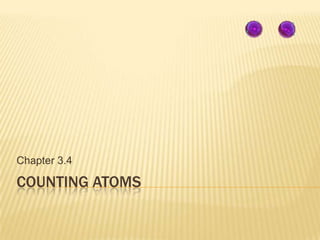
Applied Chapter 3.4 : Counting Atoms
- 1. Counting Atoms Chapter 3.4
- 2. Objectives: Compare the quantities and units for atomic mass with those for molar mass. Define mole, and explain why this unit is used to count atoms Calculate either mass with molar mass or number with Avogadro’s number given an amount in moles
- 3. Atomic Mass Mass of an atom expressed in atomic mass units ( amu ) Originally used b/c the mass of proton and neutron were approximately 1.0 amu each. Example: Copper – 63 62.940 amu Copper – 64 64.928 amu From periodic table: Copper is given atomic mass of 63.546 amu This is an average of naturally occurring isotopes
- 4. Introduction to the mole Mole : Defined as the number of atoms in exactly 12 grams of carbon – 12. SI base unit for amount of substance Used as Counting unit Instead of 12 eggs, we say 1 dozen eggs We use 1 mol of carbon or 2 mol of iron
- 5. Molar mass Mass in grams of ONE mole. Units – g/mol Find from periodic table Oxygen – 15.9994 amu Round to 16.00 amu - USE two decimal places So the molar mass of oxygen is 16.00 g/mol Find the molar masses for Aluminum Uranium Chlorine 26.98 g/mol 238.03 g/mol 35.45 g/mol
- 6. Avogadro’s Number Number of particles in 1 MOLE of a substance 6.022 x 1023 60 220 000 000 000 000 000 000 How big is this number? Entire population of Earth – 6 billion 6.00 x 109 or 6 000 000 000
- 7. Determine Mass from MOles Determine mass in grams of 3.50 mol of copper 3.50 mol Step 1: Step 2: Step 3: Write what is given Cancel out units Calculate g 63.55 x = 222 g mol 1 * Multiply everything on top From periodic table * Divide by everything on bottom
- 8. Practice Problems What is the mass in grams of 1.00 mol of uranium? What is the mass in grams of 00.50 mol of uranium? Calculate the number of moles of 0.850 g of hydrogen atoms. What is the mass in grams of 0.850 mol of hydrogen atoms? Calculate the mass in grams of 2.3456 mol of lead. Calculate the number of moles of 2.3456 g of lead. 238 g 1.2 g 0.84 mol and 0.86 g 486.0 g and 0.01132 mol
- 9. Determine number of atoms from moles Determine the number of atoms in 0.30 mol of fluorine atoms 0.30 mol Step 1: Step 2: Step 3: Write what is given Cancel out units Calculate 6.02 x 1023 atoms x = 1.8 x 1023 F atoms mol 1 * Multiply everything on top Avogadro’s Number * Divide by everything on bottom
- 10. Practice Problems How many atoms are in 0.70 mol of iron? How many moles of silver are represented by 2.888 X 1023 atoms? How many moles of osmium are represented by 3.5 x 1023 atoms? 4.2 x 1023 atoms 0.4796 mol 0.58 mol